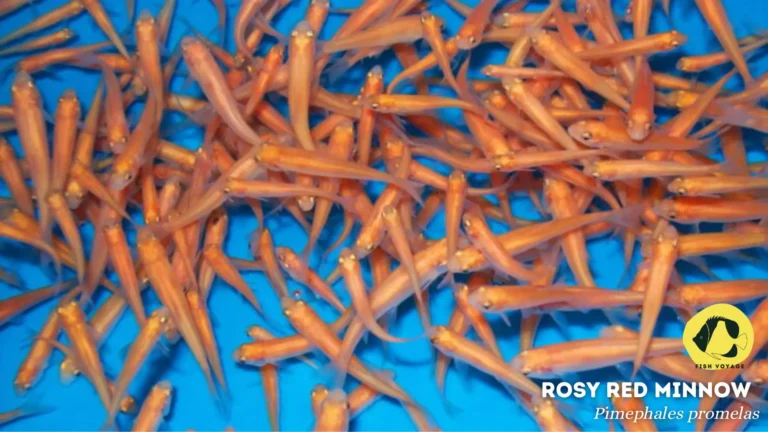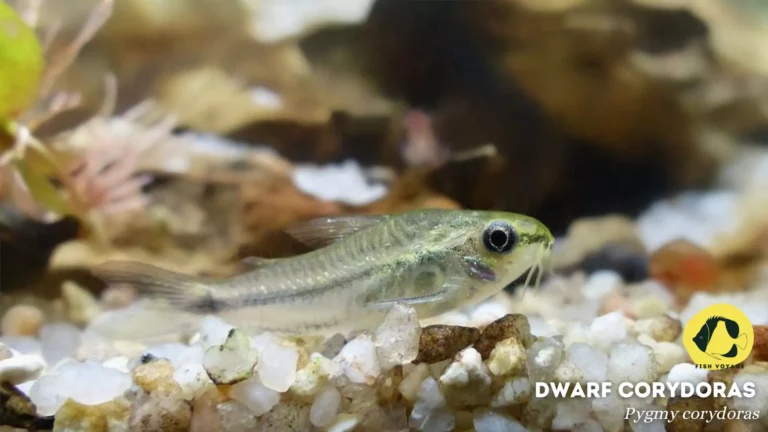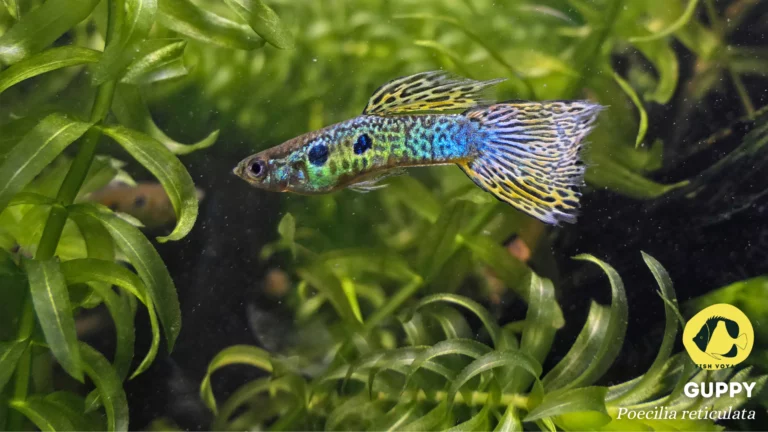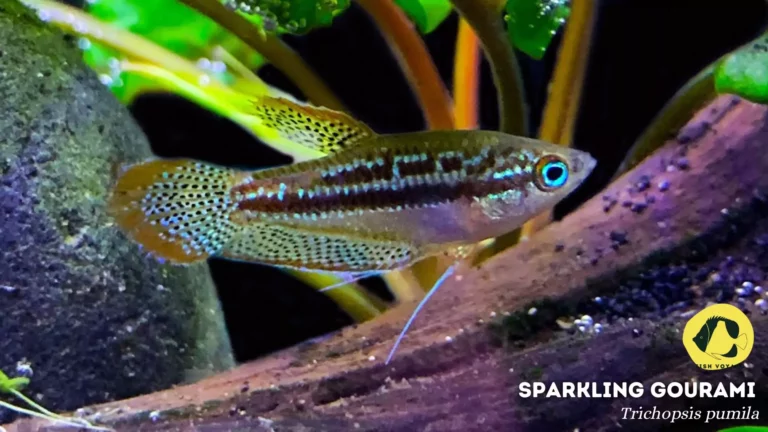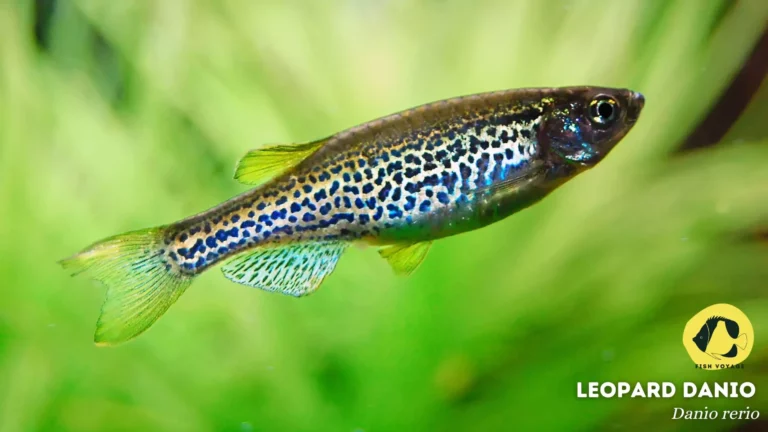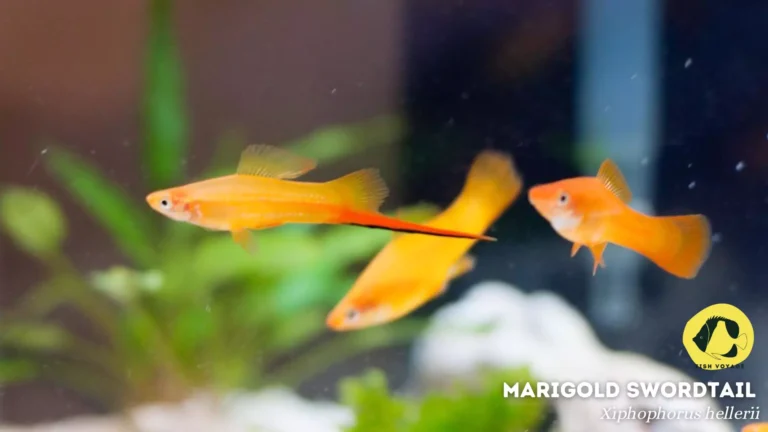Top 10 Blue Community Fishes: Ultimate List
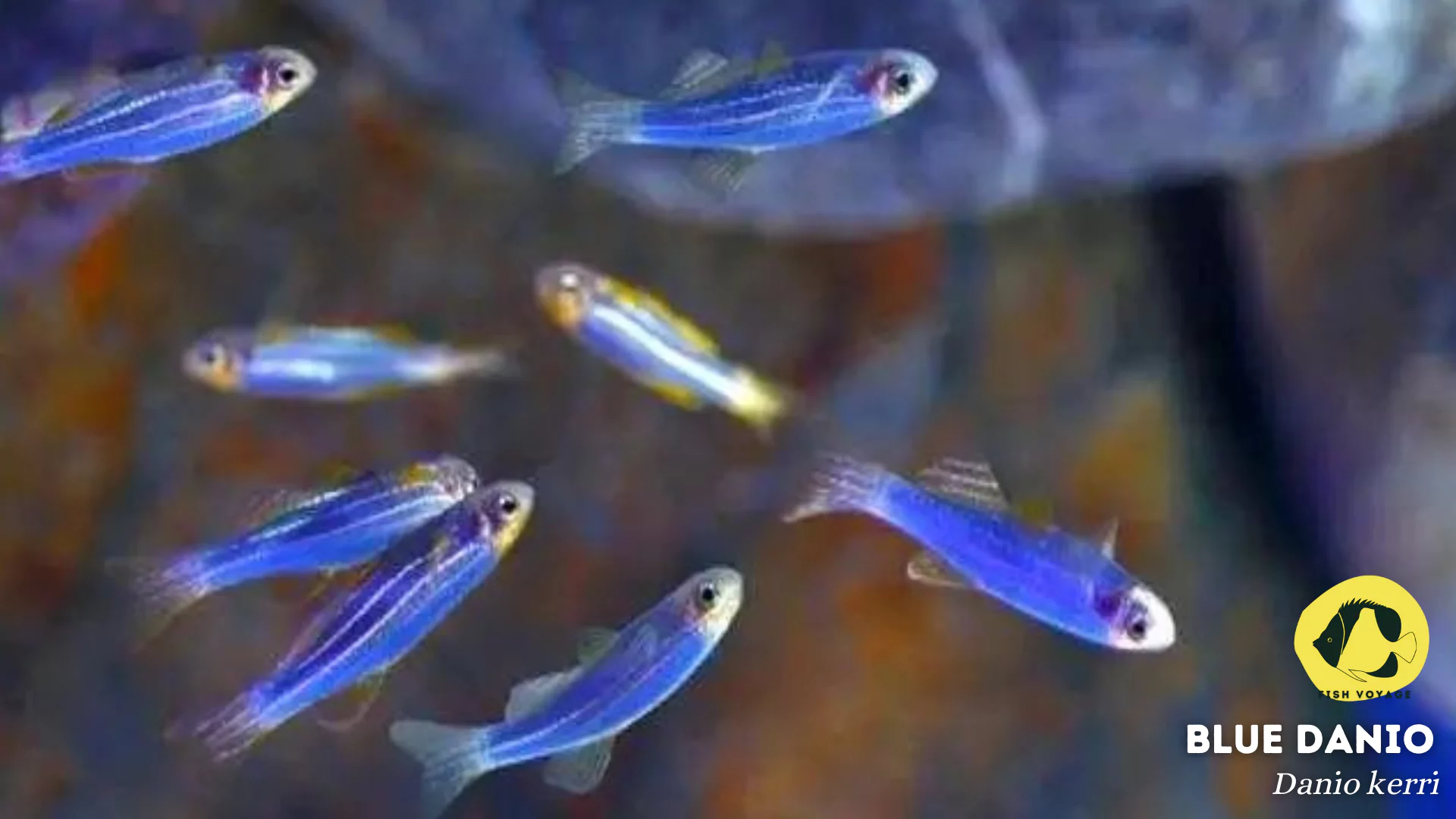
Aquarium enthusiasts worldwide have embraced the allure of community fish tanks, where diverse species coexist in harmony, creating living artworks within the confines of glass walls. The rising popularity of these communal ecosystems can be attributed to the captivating visual symphony they offer, as well as the tranquil ambiance they bring to homes and offices. Among the myriad of hues that grace these aquatic realms, the significance of color cannot be overstated. Color plays a pivotal role in enhancing the aesthetic appeal of aquariums, captivating the gaze and fostering a sense of connection with the underwater world.
In this exploration of community aquariums, we turn our focus to the mesmerizing realm of blue community fish. Blue, with its calming and ethereal charm, has become a sought-after choice for aquarists aiming to add a touch of serenity and elegance to their tanks. Join us on this journey as we delve into the world of blue community fish, uncovering the unique characteristics and joys they bring to the captivating tapestry of community aquariums.
Why Choose Blue Community Fishes?
Aesthetic Appeal and Calming Effect
The aesthetic allure of blue community fish extends beyond mere visual delight; it encompasses a profound sense of tranquility that these aquatic companions bring to a community tank. The calming effect of the azure and cerulean shades dancing through the water creates a soothing atmosphere, turning the aquarium into a serene focal point within any living space. Whether it’s the gentle glide of a Blue Gourami or the iridescent shimmer of a school of Neon Tetras, the blues in the aquarium act as nature’s own stress-relief, inviting observers to partake in the therapeutic experience of underwater beauty.
Compatibility with Other Community Fish
One of the notable advantages of incorporating blue community fish is their inherent compatibility with a wide array of fellow tank inhabitants. The amiable nature of species like the Neon Tetra and Electric Blue Ram makes them excellent team players in a community setting. Their social behavior and peaceful disposition create a harmonious tank environment, reducing the likelihood of conflicts among inhabitants. This compatibility factor not only simplifies the task of curating a diverse and vibrant community tank but also fosters a cooperative and thriving aquatic ecosystem.
Variety of Blue Fish Species Available
The palette of blue hues in the aquarium world is as diverse as it is captivating. From the iconic Neon Tetra with its radiant blue stripe to the Electric Blue Ram boasting an enchanting metallic sheen, the variety of blue fish species available allows aquarists to curate a visually stunning and diverse community tank. Whether you seek the subtle elegance of the Blue Danio or the regal presence of the Blue Gourami, the options are plentiful, catering to the preferences and aspirations of every enthusiast. This diversity not only enriches the visual tapestry of the aquarium but also provides an engaging and dynamic underwater spectacle for enthusiasts of all levels.
In embracing blue community fish, aquarists open the door to a world where aesthetics, compatibility, and variety converge to create a captivating underwater haven.
Top 10 Blue Community Fish Species
Neon Tetra
Characteristics and Care Tips
The Neon Tetra, with its iconic horizontal neon blue stripe, is a staple in community aquariums. Known for its peaceful nature, these petite fish thrive in schools, showcasing their vibrant blue and red hues. Care for Neon Tetras involves maintaining stable water conditions, with a preference for slightly acidic pH levels. Providing a well-planted environment mimics their natural habitat, ensuring their comfort and vitality.

Compatibility with Other Fish
Neon Tetras are renowned for their friendly disposition, making them excellent companions in a community tank. Their non-aggressive behavior and schooling instinct mean they coexist harmoniously with a variety of fish species. When paired with other peaceful tank mates like guppies or rasboras, Neon Tetras contribute to the dynamic and visually appealing atmosphere of a blue-themed community tank.
Electric Blue Ram
Unique Features and Care Requirements
The Electric Blue Ram stands out with its dazzling iridescent blue coloration and distinctive papillae on its head. Care for these cichlids involves maintaining stable water parameters, with a focus on slightly warmer temperatures. Quality, protein-rich food supports their health, and a well-filtered tank ensures optimal conditions for these charming fish.
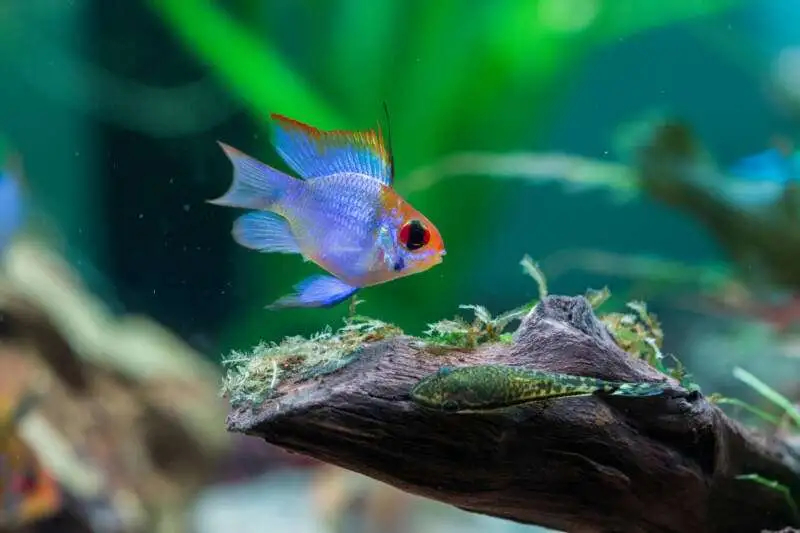
Creating an Ideal Environment
To cater to the Electric Blue Ram’s needs, aquarists should provide a well-decorated tank with caves and hiding spots. The addition of soft substrates and subdued lighting mimics their native South American habitats. In a carefully designed environment, Electric Blue Rams showcase their vibrant blue colors and exhibit their engaging social behavior, making them a prized addition to any blue-themed community tank.
Blue Gourami
Personality Traits and Tank Considerations
Blue Gouramis, characterized by their unique labyrinth organ, boast captivating blue hues and a distinctive elongated body shape. Known for their labyrinth-breathing ability, these fish thrive in calm waters. Care involves maintaining a well-aerated tank and providing floating plants. Blue Gouramis, though generally peaceful, may exhibit territorial behavior, particularly during breeding.

Community Tank Compatibility
Despite their territorial tendencies, Blue Gouramis can coexist with other non-aggressive tank mates. Careful selection of companions, such as mollies or peaceful tetras, ensures a harmonious community setting. The addition of adequate hiding spaces helps reduce territorial disputes, allowing aquarists to enjoy the regal presence of Blue Gouramis in a thriving blue-themed aquarium.
Blue Danio
Active Nature and Schooling Behavior
Blue Danios, with their energetic and active swimming patterns, add a dynamic element to community tanks. Sporting shades of blue and silver, these schooling fish thrive in a well-lit environment. Care involves providing a spacious tank to accommodate their active nature and maintaining clean water conditions.
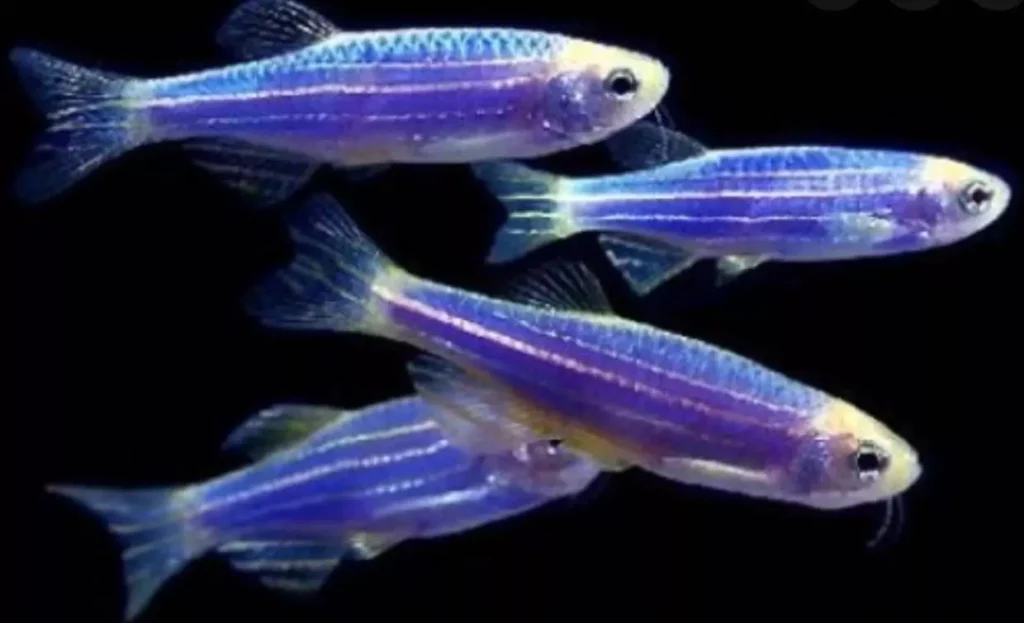
Ideal Tank Conditions
Blue Danios are well-suited for community setups, particularly when kept in schools. Their schooling behavior creates a visually striking display of synchronized movement. Aquarists should ensure a well-aerated tank with open swimming spaces, and the addition of plants enhances their natural surroundings. Blue Danios thrive in a community setting with other lively and non-aggressive species, contributing to the vibrant atmosphere of a blue-themed aquarium.
Blue Rasbora
Active Nature and Schooling Behavior
Blue Rasboras, with their vibrant blue hue, exhibit an active and playful nature, making them delightful additions to community tanks. These small-sized fish are known for their schooling behavior, creating a mesmerizing display as they navigate the aquarium together.

Ideal Tank Conditions
To cater to Blue Rasboras, maintain a well-planted tank with subdued lighting. These fish thrive in slightly acidic water with stable temperatures. A peaceful community setting with other small and non-aggressive species allows Blue Rasboras to express their social nature, adding liveliness to the aquatic environment.
Celestial Pearl Danio
Active Nature and Schooling Behavior
The Celestial Pearl Danio, adorned with celestial-like patterns and shades of blue, is characterized by its energetic swimming and schooling behavior. These small fish bring a sense of activity and unity to the aquarium as they move together in coordinated schools.
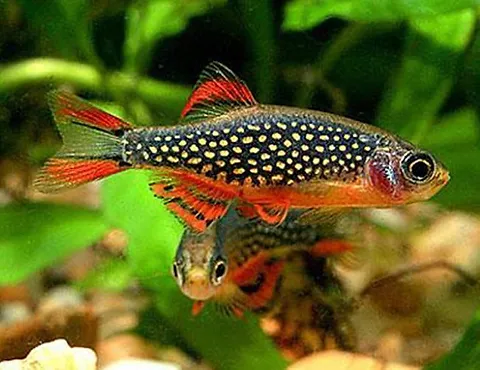
Ideal Tank Conditions
Create an ideal habitat for Celestial Pearl Danios by providing a well-filtered tank with ample swimming space. These fish thrive in slightly cooler temperatures and appreciate the presence of live plants. Their active nature becomes more pronounced in a community setting with other peaceful species.
Electric Blue Acara
Active Nature and Schooling Behavior
Electric Blue Acaras, known for their striking electric blue coloration, display an active and inquisitive nature. While they may not school in the traditional sense, they exhibit social behavior, making them engaging focal points in the aquarium.
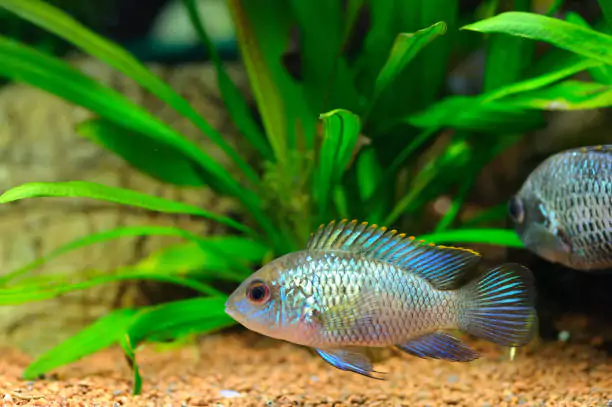
Ideal Tank Conditions
Optimal conditions for Electric Blue Acaras include a well-decorated tank with hiding spots and a sandy substrate. These cichlids prefer slightly warmer water, and their active nature becomes more pronounced when housed with compatible tank mates in a spacious community setup.
Powder Blue Dwarf Gourami
Active Nature and Schooling Behavior
The Powder Blue Dwarf Gourami, with its captivating powder-blue coloration, is an active and playful fish. While not strictly a schooling species, they appreciate the company of their kind and exhibit interesting social interactions.
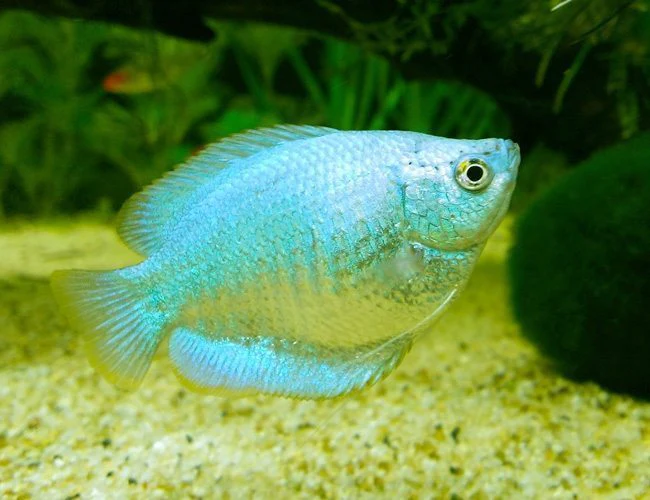
Ideal Tank Conditions
Provide an ideal environment for Powder Blue Dwarf Gouramis by incorporating live plants and floating vegetation. They thrive in calm waters with stable parameters. In a community tank with compatible companions, these gouramis contribute to the overall liveliness and color diversity.
Blue Tetra
Active Nature and Schooling Behavior
Blue Tetras, adorned with a shimmering blue color, are known for their energetic swimming and schooling behavior. These small and agile fish create a visually stunning display as they move together in unison.
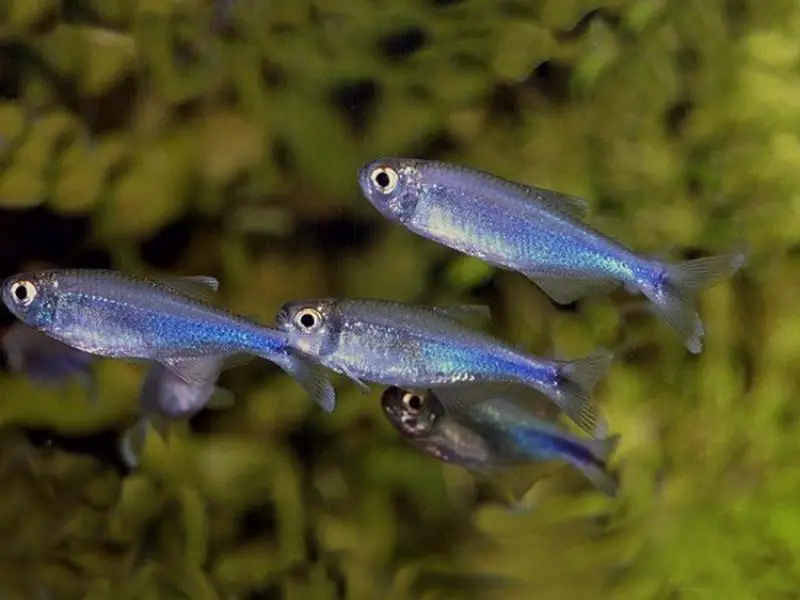
Ideal Tank Conditions
Maintain an ideal habitat for Blue Tetras by providing a well-lit tank with plenty of open swimming space. These tetras thrive in slightly acidic to neutral water conditions. When housed in a community setting with other peaceful species, Blue Tetras enhance the dynamic nature of the aquarium.
Incorporating these top blue community fish species not only adds visual splendor but also introduces unique characteristics that contribute to the overall health and harmony of a community tank.
Setting Up a Blue Community Tank
Tank Size and Design Considerations
The foundation of a thriving blue community tank begins with careful consideration of tank size and design. Opt for a tank size that accommodates the specific blue fish species you intend to keep, ensuring ample swimming space. A well-designed aquarium includes hiding spots and strategic placement of plants and decorations. The layout should mimic the natural environment of the chosen blue community fish, providing them with comfort and security.
Water Parameters for Blue Fish
Creating an environment with optimal water parameters is crucial for the well-being of blue community fish. Most blue fish species thrive in slightly acidic to neutral pH levels. Monitor and maintain stable water temperature, ensuring it aligns with the preferences of the selected species. Regular water testing is essential to keep ammonia, nitrate, and nitrite levels in check. Consider investing in a reliable water testing kit to uphold the health of your blue fish and sustain the balance of the aquatic ecosystem.
Suitable Tank Mates and Potential Conflicts
Careful consideration of tank mates is paramount to the success of a blue community tank. Choose companions that share similar water parameter requirements and temperament. Peaceful and non-aggressive species, such as other community fish mentioned earlier, make excellent choices. Be cautious of territorial or aggressive fish that may disrupt the harmony of the community. Research the compatibility of different species to avoid potential conflicts, ensuring a cooperative and thriving tank environment.
Aquascaping Tips for a Visually Appealing Tank
The aesthetics of your blue community tank play a significant role in creating a visually stunning and harmonious aquatic landscape. Incorporate live plants, rocks, and driftwood to simulate the natural habitat of your chosen blue fish. Arrange these elements strategically to provide hiding places and visual interest. Consider the color contrast and texture of the substrate to enhance the vibrancy of the blue fish. Adequate lighting not only promotes plant growth but also showcases the brilliant hues of the blue community fish, transforming the aquarium into a captivating underwater masterpiece.
In the artistry of setting up a blue community tank, attention to detail and thoughtful planning contribute to the overall well-being and beauty of the aquatic habitat. By combining the right tank size, water parameters, suitable tank mates, and creative aquascaping, aquarists can curate an enchanting blue-themed community tank that captivates both the eye and the imagination.
Maintenance and Care
Regular Water Testing and Changes
Consistent and meticulous water maintenance is the cornerstone of ensuring the well-being of blue community fish. Regularly test the water parameters, including pH, ammonia, nitrite, and nitrate levels, to maintain a stable and conducive aquatic environment. Schedule routine water changes to remove accumulated impurities and maintain water quality. Aim for a balanced and stable ecosystem, ensuring that the water conditions align with the preferences of the chosen blue fish species. Utilize high-quality water testing kits to empower you with accurate data for informed decision-making in maintaining optimal conditions.
Feeding Guidelines for Blue Community Fish
Tailoring a nutritious and balanced diet is paramount for the health and vibrancy of blue community fish. Provide a varied diet that meets the specific nutritional needs of the chosen species. Many blue fish thrive on a combination of high-quality flake, pellet, and frozen foods. Consider incorporating specialized foods that enhance the natural colors of the fish, promoting the brilliance of their blue hues. Pay attention to individual feeding habits and adjust portion sizes accordingly to prevent overfeeding, which can lead to water quality issues.
Monitoring Fish Health and Addressing Issues
Vigilant observation and proactive care are essential elements of maintaining the health of blue community fish. Regularly monitor the behavior, appetite, and appearance of the fish to identify any signs of stress, illness, or abnormalities. Swiftly address any issues by quarantining affected individuals and seeking guidance from experienced aquarists or professionals. A well-maintained and stress-free environment reduces the likelihood of health issues. Additionally, consider implementing a preventative healthcare routine, including the occasional use of fish-friendly medications or supplements, to fortify the resilience of your blue community fish.
In the realm of maintenance and care for a blue community tank, the commitment to regular testing, thoughtful feeding practices, and vigilant health monitoring forms the bedrock of a thriving aquatic environment. By adopting a proactive and informed approach, aquarists can ensure that their blue fish not only display their vibrant hues but also enjoy a life of vitality and well-being within the carefully curated community tank.
Tips for Beginners
Starting with a Small Community Tank
Aspiring aquarists embarking on their journey into the world of blue community fish are advised to begin with a small tank. A compact aquarium allows beginners to grasp the fundamentals of fishkeeping without overwhelming complexities. Opt for a manageable tank size, typically around 10 to 20 gallons, which facilitates easier maintenance and provides a controlled environment for learning the nuances of water parameters and fish care. Starting small enables beginners to hone their skills gradually and build confidence as they cultivate their passion for creating a vibrant blue-themed community tank.
Gradual Introduction of Fish
The gradual introduction of fish is a key strategy for beginners venturing into the realm of blue community tanks. Resist the temptation to populate the tank hastily; instead, add fish in stages. This approach allows for the establishment of a stable biological cycle, preventing sudden spikes in ammonia and ensuring the well-being of the fish. Begin with a small number of hardy and compatible species, observing their behavior and adjusting care routines accordingly. Patience is a virtue in fishkeeping, and a deliberate, step-by-step approach yields a more resilient and balanced community aquarium.
Seeking Advice from Experienced Aquarists
Novice aquarists are encouraged to tap into the wealth of knowledge and experience within the aquarium community. Seeking advice from experienced aquarists, whether through online forums, local clubs, or established aquarium stores, provides invaluable insights. Seasoned enthusiasts can offer guidance on species compatibility, troubleshooting common issues, and optimizing tank conditions. Engaging in conversations and asking questions fosters a supportive learning environment, helping beginners navigate the intricacies of blue community fishkeeping with confidence. Remember, the wisdom of experienced aquarists is a valuable resource on the journey to becoming a proficient and informed fish keeper.
For beginners venturing into the captivating world of blue community fish, these tips serve as foundational pillars for a successful and enjoyable aquarium experience. Embracing a small tank, introducing fish gradually, and seeking advice from experienced aquarists form the roadmap to cultivating a thriving and harmonious aquatic haven.
Conclusion
Recap of the Benefits of Blue Community Fish
In concluding our exploration of blue community fish, we reflect on the myriad benefits these captivating aquatic companions bring to the world of aquarium enthusiasts. The aesthetic allure of the blues transcends mere visual appeal, imparting a calming and ethereal ambiance to the tank. From the iridescent shimmer of Electric Blue Rams to the playful antics of Blue Danios, the variety of blue community fish species contributes to the creation of visually stunning and dynamic aquatic ecosystems. The compatibility, social nature, and ease of care make these species ideal choices for those seeking a harmonious and vibrant community tank.
Encouragement for Readers to Explore and Enjoy Creating Their Own Blue Community Tank
As we conclude, we extend an enthusiastic invitation to our readers to embark on their own journey of creating a blue community tank. The canvas is yours to paint with the mesmerizing hues of Neon Tetras, the regal presence of Blue Gouramis, and the energetic school of Blue Rasboras. Whether you are a seasoned aquarist or a beginner taking your first steps, the world of blue community fish offers endless possibilities for creativity and discovery. Embrace the joy of aquascaping, relish the process of selecting compatible tank mates, and savor the moments of tranquility as your blue community tank flourishes. Dive into the enchanting world of blue fish, and let your aquatic masterpiece become a testament to the beauty and serenity found within the confines of your very own home.
In the symphony of underwater hues, may your blue community tank bring not only visual delight but also moments of serenity and fulfillment.
Happy fishkeeping!
Additional Resources
Links to Reputable Websites for Further Information
For enthusiasts eager to delve deeper into the world of blue community fish, a wealth of knowledge awaits at reputable online resources. Explore comprehensive guides, expert insights, and community forums at trusted websites such as AquariumHub. These platforms provide a treasure trove of information on species profiles, care tips, and community discussions, empowering aquarists with the insights needed to cultivate a thriving blue-themed aquarium.
Recommended Products for Blue Community Tanks
Elevate your blue community tank to new heights with carefully curated products designed to enhance the well-being and aesthetics of your aquatic haven. Consider incorporating top-quality products such as API Master Test Kits for precise water parameter monitoring, Fluval LED lighting systems to showcase the vibrant colors of your blue fish, and Hikari Micro Pellets for a nutritionally balanced diet. For aquascaping enthusiasts, Seachem Flourish Excel and Fluval Stratum substrate offer essential elements for plant growth and a visually appealing substrate, respectively. Explore these recommended products to elevate your blue community tank, ensuring a habitat that is both visually stunning and conducive to the health of your aquatic companions.
In the pursuit of creating and maintaining a flourishing blue community tank, these additional resources and recommended products serve as valuable companions. Explore the insights offered by reputable websites and consider integrating top-tier products to unlock the full potential of your underwater masterpiece. Happy fishkeeping!
Frequently Asked Questions (FAQs)
1. What are the best blue community fish for beginners?
For beginners, popular and easy-to-care-for blue community fish include Neon Tetras, Blue Danios, and Guppies. These species are known for their vibrant colors, peaceful nature, and adaptability, making them ideal choices for those new to aquarium keeping.
2. How do I maintain the vibrant blue coloration of my fish?
Ensuring the optimal health and coloration of blue community fish involves providing a well-balanced diet rich in pigments. High-quality flake and pellet foods formulated for color enhancement, supplemented with occasional treats like frozen brine shrimp or daphnia, contribute to the vibrancy of their blue hues.
3. Can different species of blue community fish be kept together in the same tank?
While many blue community fish can coexist harmoniously, it’s crucial to consider compatibility. Research the specific requirements and temperaments of each species to avoid potential conflicts. Generally, combining species with similar water parameter needs and peaceful dispositions enhances the success of a mixed community tank.
4. What size tank is suitable for a blue community setup?
The appropriate tank size depends on the species chosen. For beginners, starting with a 10 to 20-gallon tank is advisable, allowing for easier maintenance and a controlled environment. Larger tanks, such as 30 gallons or more, offer more flexibility for diverse species and provide ample swimming space.
5. How often should I perform water changes in a blue community tank?
Regular water changes are crucial for maintaining water quality. For most blue community tanks, a 10-20% water change every 1-2 weeks is recommended. However, the frequency may vary based on factors like tank size, stocking levels, and filtration efficiency. Regular testing helps determine the optimal schedule for your specific setup.

